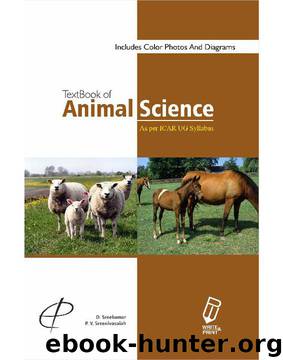TEXTBOOK OF ANIMAL SCIENCE (As Per ICAR UG Syllabus) by unknow

Author:unknow
Language: eng
Format: epub
Publisher: Mint Associates Ltd
Published: 0101-01-01T00:00:00+00:00
UNIT-9
Control of Diseases
SANITATION AND DISINFECTION
Disease is the condition in which the animal will not be at ease; it shows physiological, anatomical or biochemical changes from the normal. Health, on the other hand, is the state or condition of the animal in harmony with the environment; in simple terms, animal at ease.
1. Factors affecting health of farm animals
There are different factors affecting the health status of all animals. Some of the important factors that affect health of farm animals are:
1. Extreme climatic conditions without suitable remedial measures.
2. Faulty housing facility: this includes overcrowding, slippery/ improper flooring, mixing of age groups and improper drainage.
3. Faulty health management: improper sanitation and disinfection, and improper vaccination schedule.
4. Faulty feeding: not providing suitable quantity of ration of recommended composition / quality leads to nutritional deficiency diseases. In addition, contaminants and/or toxicants in feed and rarely excess feeding also leads to the incidence of diseases. Intake of unclean water also pre-disposes animal to diseases.
5. Lack of proper exercise and inhibition of normal behavioral patterns are other important factors leading to severe stress and the incidence of diseases in animals.
2. General requirements
The following list provides the important aspects to be borne in mind to maintain optimum health status in any herd/flock.
1. Nutritionally adequate (balanced), easily digestible and palatable feed in divided doses and at regular timings (intervals).
2. Adequate cleaning and disinfection of the farm premises, equipment, water and livestock
3. Hygienic habits of personnel attending on the animals
4. Strict adherence to routine vaccination
5. Avoid exposure to extreme climate. Provide adequate warmth during cold weather and vice versa. In either case, avoid exposure to too much bright light.
6. Culling of weak animals in the herd/flock. It is a better practice to cull all the weak animals in the farm. Weak animals have poor growth rate and limited resistance to diseases and hence, are more susceptible to infections than other animals.
7. Control of ticks and other vectors.
8. First-aid kit must be available always. In case of emergency, prompt first aid measures should be followed.
9. In case of hemorrhage, tourniquet to be applied and ice packs used to stop bleeding.
10. Assist in respiration in case of difficulty in breathing.
3. Care and management of sick animals
Sick animals need extra care and attention when compared to healthy ones. This will help in faster recovery from the illness. A veterinarian has to be requested to visit the animal facility to inspect, diagnose and suggest remedial measure(s).
3.1. Sick animal management
The following general precautions can be undertaken whenever sick animal(s) are identified in the farm:
1. Isolation – separate the sick animals from the group to a separate shed (sick animal shed).
2. Movement of people to be restricted - Attendants looking after sick animals should never be allowed to handle healthy animals. The sick animals have to be attended as often as possible.
3. Provide adequate bedding material on the floor of the shed so as to improve the comfort of the sick animal.
4. Follow strict sanitary conditions.
5. Provide fresh, clean drinking water.
6. If the disease is a
Download
This site does not store any files on its server. We only index and link to content provided by other sites. Please contact the content providers to delete copyright contents if any and email us, we'll remove relevant links or contents immediately.
International Integration of the Brazilian Economy by Elias C. Grivoyannis(57339)
The Art of Coaching by Elena Aguilar(50042)
Flexible Working by Dale Gemma;(22951)
How to Stop Living Paycheck to Paycheck by Avery Breyer(19216)
The Acquirer's Multiple: How the Billionaire Contrarians of Deep Value Beat the Market by Tobias Carlisle(11678)
The Radium Girls by Kate Moore(10910)
Thinking, Fast and Slow by Kahneman Daniel(10596)
The Art of Thinking Clearly by Rolf Dobelli(8850)
Hit Refresh by Satya Nadella(8340)
The Compound Effect by Darren Hardy(7565)
Atomic Habits: Tiny Changes, Remarkable Results by James Clear(7221)
Turbulence by E. J. Noyes(7044)
Tools of Titans by Timothy Ferriss(6952)
How to Be a Bawse: A Guide to Conquering Life by Lilly Singh(6695)
Change Your Questions, Change Your Life by Marilee Adams(6647)
Nudge - Improving Decisions about Health, Wealth, and Happiness by Thaler Sunstein(6636)
Win Bigly by Scott Adams(6319)
The Black Swan by Nassim Nicholas Taleb(6195)
A Court of Wings and Ruin by Sarah J. Maas(6095)
